Steven Sandor's Blog, page 106
February 5, 2015
Canadian midfielder Oppong returns to North America with Atlanta Silverbacks
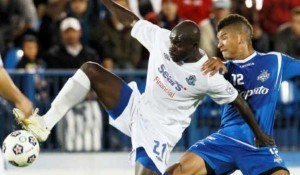
Dominic Oppong
After spending the 2014 season as teammates at Finnish second division side AC Oulu, Canadians Dominic Oppong and David Monsalve both tried their luck in the NASL.Monsalve, the former Toronto FC and FC Edmonton keeper, auditioned for the expansion Jacksonville Armada. But, in the end, the NASL side decided it was too risky to spend an international roster slot on the keeper. Monsalve moved onto Colombia, where he signed with America de Cali. (You’ll read more about this in the spring issue of Plastic Pitch magazine.)
But Oppong, a former FC Edmonton midfielder, caught on with the Atlanta Silverbacks. The NASL side announced the signing on Thursday.
“Dominic is the type of player that will fit in well with us,” Silverbacks coach Gary Smith said in a release. “He is an experienced defensive midfielder or center back and he knows the NASL well from his time with FC Edmonton.”
Oppong and Monsalve knew each other coming up as soccer players in the Greater Toronto Area, and both played under current York University coach Carmine Isacco. The duo were featured in Issue 3 of Plastic Pitch.
READ THE NEW ISSUE OF PLASTIC PITCH! CANADIAN SOCCER. CANADIAN STORIES. OUT NOW FOR APPLE and ANDROID DEVICES.
Or, visit the PLASTIC PITCH SHOPIFY STORE!
February 3, 2015
A long MLS labour stoppage could act as a massive equalizer for Gold Cup, early World Cup qualifiers
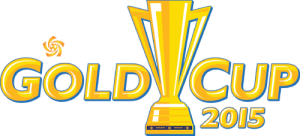 As soccer supporters in Canada, we certainly don’t want the MLS season to be interrupted by a long labour stoppage.
As soccer supporters in Canada, we certainly don’t want the MLS season to be interrupted by a long labour stoppage.
Even though the Collective Bargaining Agreement between MLS and the MLSPU expired at the end of January, the sides realistically have until MLS First Kick in early March to hammer out a new deal in order to ensure that a full season can be started on time. But the sides remain on separate poles when it comes to the make-or-break issue: Free agency. And, with every report of a cancelled bargaining session or lack of progress, the worries increase that a labour stoppage will disrupt the season.
Let’s for a second imagine that we see a nuclear option: A labour impasse that stretches for a significant period of time. The Gold Cup comes up in July; Canada’s World Cup qualifiers begin a month before that. For Canada, this Gold Cup holds special significance as it acts as our qualifier for the 100th anniversary Copa America, which is set for the United States in 2016.
So, if MLS isn’t playing games, how would it affect the Canadian program?
Canadian Soccer Association president Victor Montagliani said that this country’s national team would end up faring a lot better than some of the competition.
“From the technical side, there are a handful of players in MLS who could be part of the team that would be at the Gold Cup. And it would hurt if those players weren’t playing. But, when you look at all the countries in CONCACAF, we might be one of the ones least affected by an MLS work stoppage. Certainly, it would not affect us like it would the United States, where the majority of their players play in MLS.”
I spoke with Montagliani to get his take on Canada’s relationship with U.S. soccer and leagues such as MLS, NASL and NWSL. That full interview will be featured as part of the spring 2015 issue of Plastic Pitch — an issue that will solely be devoted to looking at the soccer relationship between Canada and the U.S. It will ask the question: Has Canadian soccer been helped or hurt by its relationship with our neighbours to the south?
But we did speak for a bit about MLS and its CBA uncertainty.
“My concern is for the game of soccer in general if there is a work stoppage,” said Montagliani. “I hope the players and the league can come up with a win-win solution that is beneficial to both sides.”
The fact that Canadians count as imports on American teams but as domestics on the Canadian ones — while the Americans are domestics on both sides of the border — has created an MLS where very few Canadians now ply their trade in the U.S. And for those who play in the U.S., how many do we see as Gold Cup or World Cup qualifying keys? Will Johnson is recovering from a serious leg break , and you couldn’t say that Kyle Bekker or No. 1 SuperDraft pick Cyle Larin would be locks to make a Gold Cup squad. So, if a lockout or strike was to run into the early summer, Canadians would be concerned to see players such as Toronto FC’s Jonathan Osorio, Whitecap Russell Teibert or Montreal Impact players such as Karl Ouimette and Patrice Bernier not getting competitive minutes.
Heck, because Canada has relied heavily on Unattached FC over the last year, we can (sort of) jokingly say that we’re better prepared than any other nation on the planet to have a chunk of our top players go into a top tournament without any real competitive games under their belts.
But the Canadian situation wouldn’t be anywhere as close to being as bad as it would be for the United States. MLS has worked to repatriate many national-teamers and fringe national teamers; so from Clint Dempsey to Michael Bradley to Jermaine Jones to Jozy Altidore to Mix Diskerud, American coach Jurgen Klinsmann could have to choose from a lot of players whose only soccer action is at the negotiating table.
The U.S. and Mexico are already Copa America invitees. Costa Rica, as Copa Centroamericano champions, is also in. Jamaica, Caribbean Cup winners, is also in. Two more CONCACAF spots remain open for the Copa America, and they will be decided through the Gold Cup.
So, who else would be affected? Guatemala finished a surprising second at the Centroamericano and will be a Gold Cup player; its most important player, Marco Pappa, could be on picket lines leading up to the tournament. Honduras could have to deal with striker Oscar Boniek Garcia, midfielder Luis Garrido and defender Victor Bernardez not being able to play league games. Panama could see striker Blas Perez waiting for FC Dallas to play a game.
Jamaica and Costa Rica, while already having qualified for the Copa America, could also be hamstrung for Gold Cup. And, Canada could still have to play meaningful games against those sides. Costa Rica is set to play in a group that will play some of its games at Toronto’s BMO Field, so we’re all betting that Canada might be drawn there.
It’s still a long way off, but if the MLS and its union remain at an impasse into May, the pressure from the national federations will come. They’ll want their players playing, not sitting, as CONCACAF nations prep for the Gold Cup. Some, who begin World Cup qualifying early in the CONCACAF process, will heap added pressure.
If MLS is on hold for months, it could act as a hell of an equalizer for the CONCACAF stage.
READ THE NEW ISSUE OF PLASTIC PITCH! CANADIAN SOCCER. CANADIAN STORIES. OUT NOW FOR APPLE and ANDROID DEVICES.
Or, visit the PLASTIC PITCH SHOPIFY STORE!
January 29, 2015
Before you tweet about a Canadian player, read this first
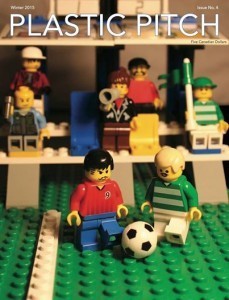 Some days, writing about Canadian soccer is depressing. Some days, I swear to myself “this is the last article about Canadian soccer I’ll ever write.”
Some days, writing about Canadian soccer is depressing. Some days, I swear to myself “this is the last article about Canadian soccer I’ll ever write.”
Of course, that would make some of my harshest critics very happy indeed.
I’ve been very public about Issue 5 of Plastic Pitch. A group of great writers are working on stories about our relationship with the American soccer system. Is having Canadian pro teams mixed into the American system good for the our country’s development in the game? Has it actually hurt us?
Through the last few weeks, I’ve been working to get Canadian players to tell their stories. Many Canadian soccer writers hear the tales about aborted contracts, bizarre under-the-table deals, broken promises, fly-by-night agents and the like. But players, understandably, are worried about coming forward. They don’t want to be seen as bad eggs, dressing-room malcontents or selfish players.
But, finally, slowly, some players are coming forward. Until the stories have faces, the system won’t change. But in the process of putting stories to paper, you can’t help but get snowed under by it all. You wonder if supporting Canadian soccer is like plunging into an endless pit of hopelessness. You understand how the cards are stacked against our players. Those stories will be (at least partially) told in the next issue. It will be by far the most important thing we’ve done.
There is something I want to address, though. Something I’ve thought hard about in the process of doing these interviews. We’re in that part of the NASL and MLS silly season (and right near the closing of the transfer window). So, the message boards and Twitter are filled with jokes about the number of Canadian players on Unattached FC. Many fans wonder “why doesn’t player A try to join NASL Team X or MLS Team Y? Why doesn’t he take a chance to play halfway across the world?”
The problem is that most Canadian soccer fans see the players as single guys. They don’t see them as husbands or dads. They don’t see them trying to make their relationships work.
Luckily enough, I’ve become close to enough players to know when they’ve got married, when they’ve had a son or daughter. I wave to some of the moms and dads of the players at FC Edmonton matches. But, as every journalist would, we don’t write about their partners or kids unless they somehow impact the stories. And that’s super rare.
While working on the next Plastic Pitch, I spoke to a player who is a dad. We joked that playing soccer is a single man’s game; the stakes change once you have a child. That player could have played in the United States this season, but he would have had to leave his family behind. And the contract was just enough for a single guy to barely stay afloat — for a family man, it was out of the equation. He’d have nothing to show for it financially at the end of the season; no money to put away for his child.
I know players who play in Europe, then meet Mrs. Right. That impacts their decision on whether they want to come back to North America or not. And if the player does wants to come back, he has to consider how easy it will be for his wife/partner to get status so she can legally work and live in the state or province of choice.
I’ve seen players turn down deals because their wives make more money than they do; and asking her to leave her job so he can play three time zones on a non-guaranteed contract is downright unreasonable. I’ve seen other players in crazy long-distance relationships.
So, next time you wonder about the players on Unattached FC, ask yourselves these questions before you hit Twitter or the message boards.
• Is that player married? Does he have kids? Can he support a partner and kids on a minimum NASL or MLS salary?
• If he has a family, does a U.S. team pay for their health-care insurance?
• What’s the tax rate like where he’ll play? For example, if he’s making $50,000, how much is the government taking? What’s the cost of living in that city?
• Does his partner work? How good is that job? Is it better than anything the player could hope to make if he moved to another team? Based on the contract, would he have any money to put away/take home at the end of the season?
As one player told me, as a Canadian playing the game professionally, you need to ask yourself a lot of hard questions if you want to have a family.
Yes, these are the same questions we ask of ourselves when we consider if we should take a new job. So why is it that we don’t offer soccer players — who are by no means making big money in North America or in smaller European leagues or lower divisions — the same courtesy?
READ THE NEW ISSUE OF PLASTIC PITCH! CANADIAN SOCCER. CANADIAN STORIES. OUT NOW FOR APPLE and ANDROID DEVICES.
January 28, 2015
Fort Mac games means Eddies will spend much of the summer outside of Edmonton

The Eddies will play two “home” games at Fort Mac’s Macdonald Island facility this season.
On Wednesday, FC Edmonton confirmed that the dates on which it will play its two Fort McMurray “home” games.As had been expected, the Eddies’ fall season opener — kicking off just hours before the Women’s World Cup final in Vancouver — will go July 5 in Fort Mac. The NASL champion San Antonio Scorpions will provide the opposition. The Eddies will return to the heart of the oil sands on Aug. 2 for a match against the Ottawa Fury.
The team had announced last season that two games would be coming to Fort McMurray. But, with the announced dates comes a real test for the Edmonton market.
Because of the Women’s World Cup, FC Edmonton has to clear out of Clarke Stadium — which is an official practice facility for the teams — by the end of May. The team’s final home game of the spring season goes on May 24.
The next time Edmonton is at “home” is the July 5 Fort Mac game. It then goes out on a three-game road trip. FC Edmonton is finally back at Clarke July 26, but then is back in Fort McMurray the next weekend (Aug. 2).
So, after the May 24 home game, FC Edmonton will only have one home game at Clarke Stadium (July 26) before the second week of August. That’s a heck of a long time to be out of the eye of the local media and soccer community.
Tickets for the Fort Mac games will go for $12-$32.
The Fort McMurray games will be the northernmost fully professional matches ever played in North America.
Is Sunday the worst sports day of the week? A fascinating Edmonton study
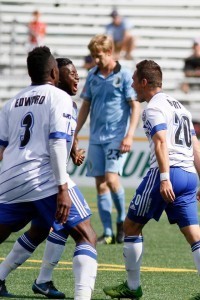
FC Edmonton plays almost all of its home games on Sunday afternoons.
Major League Soccer plays some of its games on Sunday afternoons and evenings. FC Edmonton of the NASL plays all of its home games on Sunday afternoons.
But is Sunday a day that we, as in Canadians, actually want to watch sports? Or is it a day that we’d like to get away from the sporting universe? Even the most ardent fan reaches a critical mass, where he or she says “enough” and needs to do something else than follow scores and trades and watch game after game. You need to spend time with the kids, go to the lake, just get outside, talk to real people.
In the course of my editing duties at Avenue Edmonton, members of the Edmonton Eskimos brass — our city’s Canadian Football League team — sat down with me to go over an intense survey that they and Banister Research Consulting Inc. conducted. One of the key questions was: On what day do you prefer to watch Eskimos games? (You can find that full article HERE, BTW). The results were fascinating.
43 per cent said their first choice was Friday nights.
41 per cent said their first choice was Saturdays.
And — get this — only seven per cent said they’d most prefer to watch football on Sundays.
Now, understand that this isn’t a soccer survey; it’s not a national survey. It’s a survey of Edmontonians — commissioned by a CFL team. But you have to wonder if those numbers would hold steady on a cross-Canada level and if it’s true of all sports.
If the numbers do bear out — it’s a sign of just how different the preferences of Canadians are than Americans. The concept of super-NFL-Sundays comes from our American friends — and it permeates our culture. There’s no denying it. But, what if there is a lesson here for Canadian sports teams — including NASL and MLS sides? That, for the best possible gates, kick off your games on Friday nights?
Now, for those of you who read our companion magazine, Plastic Pitch, you may recall that in our Fall Issue (Issue 3), John Molinaro wrote about how he believes that MLS moving games — especially post-season games and even MLS Cup — to Friday nights would be good for the league. This survey gives more food for thought.
It needs to be said that sports scheduling isn’t always about the best nights to get fans’ bums in seats. A lot of it has to do with television. In a place where hockey rules the universe on Saturday nights in ever month but July, August and September, it means the other teams need to slot games in ways that can still get them exposure. For Edmonton, Sunday afternoons is optimal for local TV. The study should just be food for thought — but you wonder if FCE played Friday nights at 7 p.m. local, if the Eddies wouldn’t help their attendance numbers.
READ THE NEW ISSUE OF PLASTIC PITCH! CANADIAN SOCCER. CANADIAN STORIES. OUT NOW FOR APPLE and ANDROID DEVICES.
January 22, 2015
Weak Canadian dollar is bad news for Canadian soccer franchises
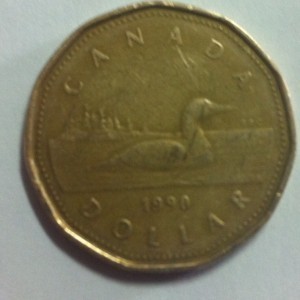 For some businesses — a weak Canadian dollar is a good thing.
For some businesses — a weak Canadian dollar is a good thing.
Professional sports is definitely not one of them. The Canadian dollar flirted with the US 80-cent mark on Thursday. And, the currency plunge will soon be hurting the bottom lines of Canadian MLS and NASL teams.
MLS and NASL teams aren’t forthcoming about the terms of their contracts. But the MLS Players Union sheds some light on how the salaries are paid out. According to MLSPU Executive Director Bob Foose: “All contracts are calculated in U.S. Dollars, players can then choose to have them paid in either, or a combination.”
So, according to the union, it’s the player’s (or agent’s) call when it comes to determining if the cheques are paid in American or Canadian dollars. And, it’s hard to imagine a player not choosing to get paid in the more stable currency — the Yankee dollar. In the NHL, where there are seven teams out of 30 are Canadian, contracts are paid out in U.S. figures — including Canadian players on Canadian teams.
Toronto FC has confirmed that all MLS salaries are in US dollars.
The salaries we see published by the MLS Players Union are all in American dollars. So, if Toronto FC has Designated Player Michael Bradley on for an MLSPU-reported salary of $6.5 million, that’s American dollars. So, as of Thursday’s exchange rate, Bradley’s salary is now at nearly CDN$8.05 million, and going up (in Canadian currency) as the loonie plummets.
Try this as a comparison: At the start of the 2014 MLS season, the Canadian dollar was at 90.2 cents US. So, a year ago, Bradley’s contract was worth about $7.2 million in Canadian bucks. This year, it’s over $8 million. And that’s all because of the plunging dollar.
On the NASL level, both FC Edmonton and the Ottawa Fury have officially stated that the plunging dollar has yet to harm their businesses.
But, for all Canadian teams, it’s a dangerous combination — their ticket sales and majority of sponsorships are paid in Canadian dollars, which are dwindling in value. But their biggest expenses — player salaries — are “calculated” (I’m being careful to use Foose’s word, here) in American dollars. So, for each cent the loonie drops in value against the Canadian dollar, the disconnect between revenue and expenses widens. And even though the NASL teams are not saying much at the moment, it will eventually hurt them if the loonie remains this low — or drops even further.
And, travel expenses go up, too. For Canadian teams in MLS and NASL, the majority of road trips are to American destinations. Hotel bills are paid in American dollars, per diems in American dollars, expenses in American dollars.
Ian Clarke, the Chief Financial Officer of Maple Leaf Sports and Entertainment, put it this way when addressing TFC and the weak loonie.
“For our planning purposes, the goal is to have a level of certainty. With that, we can plan and move forward accordingly. Sometimes when we hedge we win and sometimes we don’t, but what we do have is certainty and peace of mind and we are able to plan accordingly.”
The loonie’s drop has been linked to the plummet in oil prices; but it was accelerated by the Bank of Canada’s to slash already-low interest rates. They are a direct reflection of how overly reliant Canada is on the fossil-fuel economy; and it’s amazing to see the domino effect that low oil prices can have on some Canadian businesses that are located time zones away from Fort McMurray.
Remember that in 1996, the National Hockey League launched the Currency Equalization Program to partially shield small-market Canadians teams from the hardship of currency disparity. At that time, the loonie was at around 74-75 cents American. But it’s worth noting that the NHL did not have a salary cap at the time; and asking the Oilers, Flames and Senators to compete with the likes of the free-spending Rangers and Flyers — with a Canadian dollar that was weak — was too big an ask. Remember, the low dollar was a contributing factor in the near-relocations of the Oilers and Flames. The Winnipeg Jets had just moved to Phoenix, and NHL Commissioner Gary Bettman said a major reason that the team had to move was because no new local suitors had appeared to keep the team in Manitoba. And, with the dollar where it was in 1996, and player salaries on an upward trend, it’s hard to argue that coming forward to save the Jets would have been anything but a bad investment. When the Atlanta Thrashers relocated to Winnipeg in 2011, the Canadian dollar was trading above par. That’s massive difference from the economic picture of the mid-1990s.
In 1998, the governors of the Canadian NHL teams appeared before parliament to discuss the challenges of operating in a North American league — and to explain the issues posed by a weak Canadian buck.
According to then-Senators governor Rod Bryden, the formula was a deadly one.
“Like the technology corporations, we must compete for our talent from and with the best in the world. We must compete for the spending of our ticket buyers and our advertisers against mainly U.S.-produced alternatives. Unlike our friends in the technology industries, we pay 80 per cent of our expenses in U.S. dollars and we receive 80 per cent of our revenues in Canadian dollars. That’s the inverse of a typical technology company.”
Unlike the NHL of the 1990s, MLS of 2015 does have a strict salary cap, and players can’t move as freely as they did — and still do — in the NHL. MLS players have said that free agency will be the big hill of the Collective Bargaining Agreement battle — the MLS CBA expires on Jan. 31 — but it’s still unlikely to see MLS come close to the spending of any of the other major American sports leagues. But, the fact is, for every cent the dollar drops, the expenses of the three Canadian MLS teams rise. And it’s not like they can go back to fans and say “whoops, we based our season-ticket prices on an 85-cent dollar, not a 75-cent dollar, so you’ll all need to cough up an extra 10 per cent on those seats.”
As the dollar slides, the American teams gain a competitive advantage over the U.S.Canadian clubs. MLS has long touted the “competitive balance” as being one of the key reasons it has certain rules in place — such as allowing Americans to be treated as domestics on Canadian teams. But the biggest saboteur to competitive balance could be the currency issue.
READ MY PIECE IN ALBERTA VENTURE ON THE ECONOMICS OF FC EDMONTON: (CLICK HERE)
READ THE NEW ISSUE OF PLASTIC PITCH! CANADIAN SOCCER. CANADIAN STORIES. OUT NOW FOR APPLE and ANDROID DEVICES.
Back in the fold: Zebie signs deal with FC Edmonton
 Allan Zebie didn’t take the most direct route to an FC Edmonton contract. But he got there.
Allan Zebie didn’t take the most direct route to an FC Edmonton contract. But he got there.
On Thursday, the Eddies announced that the France-born, Canada-raised fullback — who played with Canada’s U-20 side in 2013 — has been signed. Zebie, now 21, joined the FCE Academy in 2012 but left to explore options in Europe. He had trials with Rangers, a club that once employed FCE coach Colin Miller (and is still close to his heart) and Leeds United. In 2014, Zebie returned to Edmonton and spent much of the season training with the Eddies.
Zebie said he only spent a week at Leeds, but had a positive first three days with Rangers. And then Murphy’s Law came into play.
“I was supposed to be there for a week, I was there, Monday, Tuesday, Wednesday, then they asked me if I could stay another week. But then I got injured.”
Zebie hoped to get back to Rangers once he got healthy, but a deal never worked out.
In 2014, he joined the Eddies when they in their mid-season camp in Vancouver, then spent the next few months training with the first team. He impressed enough to earn himself the contract.
Zebie said that he can play on either the left or right side.
FCE assistant coach Jeff Paulus said that many of the first-team players would say tha Zebie was one of the hardest players to beat one-vs-one in the training session.
“He’s a very difficult player to beat one-vs-one and he works extremely hard,” said Paulus. “He’s not a flashy player, but he plays a clean ball out and can get forward when the opportunity’s there.”
Allan’s younger brother, Bruno, is with the FCE Academy, but Paulus said there have been some discussion about seeing if there is a way the Eddies can loan him out to a USL-PRO or PDL team, so he can see some higher-quality game minutes. Paulus said the club has an excellent relationship with Calgary Foothills, which will begin PDL play in 2015. If Foothills’ status will allow it to take on pro players, then it could be a destination for some of the Eddies’ young first-team players who need minutes.
Paulus said it could be a great opportunity for the Eddies if they could place some players on the Vancouver Whitecaps’ newly minted USL-PRO squad. But there have been no discussions between the clubs on that level.
January 20, 2015
FCE fall-season opener conflicts with WWC final: How NASL blew the fall schedule
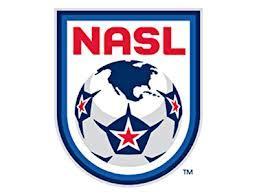 The NASL fall schedule came out on Tuesday. And one game sticks out like a sore thumb.
The NASL fall schedule came out on Tuesday. And one game sticks out like a sore thumb.
And that’s FC Edmonton’s fall season opener, which will go July 5 at 2 p.m. (local time) against the San Antonio Scorpions. Considering that the game still occurs in the Women’s World Cup window — the money is on that being one of the two fall-season games that will be hosted in Fort McMurray, though the club isn’t expected to confirm those dates till next week.
Oh, did I mention the World Cup window? Actually, the game will happen on the same day as the Women’s World Cup final. The FC Edmonton-San Antonio game kicks off just three hours before the big game at BC Place goes forward.
By playing on the same day as the Women’s World Cup Final, whether it be in Edmonton or Fort McMurray, the Eddies will likely be largely ignored that day. And, flights from Alberta to Vancouver are short in duration and plentiful in supply. So, chances are more than a few Alberta-based fans who could have been at the Eddies game will be in Vancouver for the big final. (Now, those odds are lessened if the game is placed in Fort Mac — as it will likely be treated as a special event).
According to the Eddies, the game date won’t be changed. And, according to the Eddies, had they started the season with a road game, the team would have faced a four-game jaunt away from home to start the season. After the July 5 date, the Eddies go on a three-game road trip and aren’t slated to play at home again till July 26. So, there was a push to get the Eddies a home game early in July.
So some of the fault lie with NASL, for not figuring out it should try not to stack the Eddies with so many road games later in July — and basically force a conflict with arguably the biggest soccer game this country will ever host. Does it make sense that the NASL is ballyhooing its July 4 opening weekend schedule, but having a Canadian team play at home? Seriously, if getting fireworks and hot dogs into the schedule was such a big deal, why not have the Eddies open the season on July 1 — Canada Day?
Whoops. Looks like the Ottawa Fury is playing at home on July 4, too (against Jacksonville). So that’s two instances where NASL could have had American teams playing at home for the big Yankee Doodle Dandy weekend, but decided to schedule games in Canada, instead.
READ THE NEW ISSUE OF PLASTIC PITCH! CANADIAN SOCCER. CANADIAN STORIES. OUT NOW FOR APPLE and ANDROID DEVICES.
January 19, 2015
Scary thought: De Ro is STILL Canada’s best scoring option
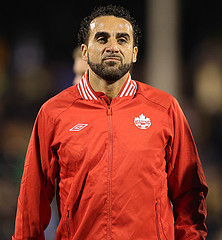
Dwayne De Rosario
So, national-team coach Benito Floro called in an experimental, youthful lineup to face Iceland in a pair of friendlies, the second of which was played Monday.Canada lost the first game, 2-1. On Monday, the Canadians had to settle for a 1-1 draw with Iceland as Hólmbert Fridjonsson converted a second-half penalty after Manjrekar James committed a foul in the box.
With so many new, fresh faces on call in the two Florida friendlies, of course it would be the elder statesmen who would score both goals. Dwayne De Rosario, currently without a club, headed home a goal in the first game and scored from the penalty spot in the second. He now has 22 goals in his Canadian national-team career. He’s padded his lead atop the Canadian all-time scoring list.
De Rosario will turn 37 years of age in May. And he still remains our country’s best scoring option. The fact that De Ro is a necessity, and not a luxury, for Floro, is a sign of just how badly we have failed as a nation to produce goal-scoring skill players. When Canada begins World Cup qualifying this June, it would be hard to make a case for not having De Ro on the squad. It might be hard to make a case that he shouldn’t start.
And with De Ro still scoring goals for Canada — and being part of the national-team set-up — so grows the need for a club to take a chance on him, so he can have minutes under his belt when Canada starts playing games that matter again.
It doesn’t matter if its Dominica or the British Virgin Islands that Canada will face in World Cup qualifying in June. The fact is, our program is not at the spot where we can consider anyone a minnow. We’ll need our best scoring options for both of the legs of that CONCACAF second-round match. And DeRo continues to prove himself to Floro.
READ THE NEW ISSUE OF PLASTIC PITCH! CANADIAN SOCCER. CANADIAN STORIES. OUT NOW FOR APPLE and ANDROID DEVICES.
Dissecting another U-20 loss: Why didn’t Hamilton start for Canada?
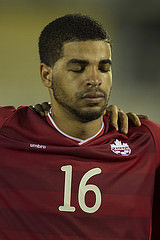
Jordan Hamilton
Canadian coach Rob Gale has held to the same philosophy throughout the CONCACAF U-20 Championship; that he has to keep the squad fresh.After losing two of its first three games at the tournament, Gale had some difficult roster decisions to make for Monday’s must-win date against Cuba. The Cubans won 2-1, and Gale’s rotation policy will now be under scrutiny.
He elected to keep Jordan Hamilton, who scored twice against Haiti in the opener and had some effective runs in a loss against Mexico, on the bench for the start of the Cuba game; instead, Cyle Larin got the job up top. Larin, unfortunately, has not lived up to the No.1 MLS SuperDraft pick hype throughout the tournament; he was ineffective in the loss to El Salvador, and headed the ball over the goal on his best chance of the game against the Cubans.
The decision to leave Hamilton on the subs’ bench at kickoff helped limit Canada’s goal-scoring options. And Hanson Boakai’s absence will force Gale to answer even more questions.
In Canada’s previous match, against El Salvador, Boakai responded with a wonderful second-half performance. He scored a fantastic goal and created several more good chances. When he ran at defenders, they were on their heels. Even though Canada lost on a last-kick-of-the-game goal, there was no denying that Boakai roused a sluggish offence from its slumber, and was our country’s best player on that day.
Boakai had been nursing an injury going into the tourney, and Gale warned that his minutes would be limited. n aggravation of the existing issue or a new knock would be the only explanations to keep the kid out of this game.
With only one win out of its first three games, Canada had to treat the game with Cuba as a must-win. The Canadians no longer had the luxury to look past Cuba and save bodies for the final group-stage game against Honduras. The Canadians needed to use their best win-now options. So it was strange to see Hamilton — who didn’t start the game against El Salvador, either — not come in until just after halftime. And Boakai’s total absence from the match was just as mysterious.
Through the two most recent games, Larin has become the favourite for minutes, even though Hamilton’s returns have been better. For sure, Hamilton may have needed some rest against El Salvador — hence why he didn’t come into that game till the 81st minute — but Larin had a chance to prove something in that game, and didn’t come up with a finished product. And with that rest, Hamilton could have been ready to start against Cuba.
Even if Hamilton wasn’t at 100 per cent, if Hamilton was only available for 45 minutes, why not use him in the first half, where Canada’s most effective striker could help peg the hosts back and set a tone for the game?
Canada gave up two awful goals in the first half — both to Frank Lopez. On the first, keeper Nolan Wirth totally flubbed his clearing attempt. The ball rolled right to Lopez, who chipped the ball over Wirth and into the goal. And Lopez was allowed to climb and head in his second even though he was surrounded by Canadian defenders in the box.
Jackson Farmer knocked home a volley in the second half.
The Cubans bunkered in the second half and saw out the rest of the game. And Canada fell to a team that had lost to the Mexicans 9-1 earlier in the tournament.
READ THE NEW ISSUE OF PLASTIC PITCH! CANADIAN SOCCER. CANADIAN STORIES. OUT NOW FOR APPLE and ANDROID DEVICES.



